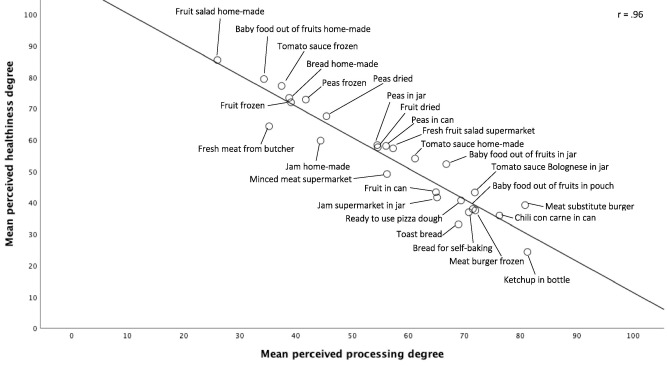
This study looked at consumer perceptions surrounding the healthiness of processed foods and how this relates to food classification systems and nutrient profiling. It involved an online survey of 498 Swiss consumers. Participants were asked to describe their associations and feelings towards ‘food produced by the food industry’.
They were also asked to score 27 foods in terms of their degree of processing and how this relates to their perceived healthiness. Results of this survey were then compared to the NOVA and Nutri-Score systems which assess levels of food processing and nutritional value, respectively.
The phrase ‘food produced by the food industry’ was generally associated with terms like ‘convenience food’, ‘unhealthy’, and ‘additives’. Associations were overall more negative than positive. Moreover, following scoring of the 27 foods a clear pattern emerged: as perceived degree of processing increased, perceived healthiness decreased (see figure below).

Image: Figure 2, Hässig et al., 2023. Correlation between mean processing perception and mean healthiness perception of 27 food products.
The NOVA system classifies food based on the ‘extent’ and ‘purpose’ of food processing. It consists of four major categories: minimally processed food; processed culinary ingredients; processed foods; and ultra-processed foods. Respondents' perceived degree of processing for each of 27 different food products overlapped significantly with the corresponding NOVA categories. For example, products in category 4 (ultra-processed foods) of NOVA were primarily perceived as the most processed.
There was also significant overlap between participant responses and the Nutri-Score assessment of nutritional value - foods perceived as less healthy had lower nutritional value according to the Nutri-Score system. Finally there was also broad agreement between the NOVA and Nutri-Score systems: foods categorised as more highly processed by NOVA had lower nutritional value according to Nutri-Score.
Overall this study confirms that consumers use the degree of food processing to inform decisions on food healthiness, and these perceptions overlap with the NOVA food classification system. It concludes that since the level of processing does not always accurately reflect healthiness it is important for food manufacturers and nutritionists to help consumers better understand the nutritional value of foods.
Abstract
Demand for processed food is increasing, but at the same time, some of these products have been strongly criticised for causing non-communicable diseases. Only a few studies have analysed consumers’ perceptions of food processing and, especially, ultra-processed foods. We examined consumers’ associations with processed foods, as well as how their processing and healthiness perceptions are related to food classification systems (i.e. NOVA) and the nutritional value of foods (i.e. Nutri-Score). An online survey was conducted with 498 Swiss consumers, who indicated their associations with the term ‘foods produced by the industry’. Furthermore, the respondents indicated how they perceived the healthiness and degree of processing of 27 foods that differed in how much they had been processed. The results suggest that consumers have rather negative associations with food processing. Consumers use the perceived degree of processing as a cue in their evaluation of the healthiness of foods. The use of this heuristic may result in biased decisions. Furthermore, we found a strong agreement between laypeople’s perceived level of processing and the NOVA classification system.
Reference
Hässig, A., Hartmann, C., Sanchez-Siles, L., and Siegrist, M., 2023. Perceived degree of food processing as a cue for perceived healthiness: The NOVA system mirrors consumers’ perceptions, Food Quality and Preference.
View the original article here. See also the Table Explainer What is ultra-processed food? And why do people disagree about its utility as a concept?







Post a new comment »